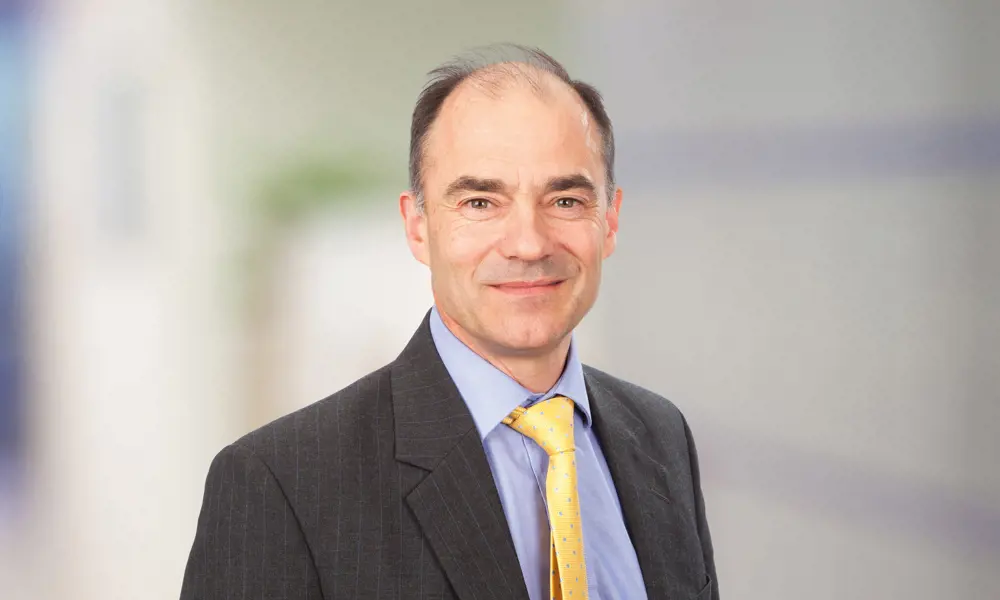
Taking engineering to industry
Rolls-Royce hadn’t had an engineer at its helm for 25 years until Warren East CBE FREng became CEO in 2015. East didn’t even join the engineering company with the idea of becoming CEO. He was enjoying something of a gap year, what he describes as self-imposed ‘gardening leave’, after nearly 20 years at ARM, one of the country’s most successful electronics companies. He had spent 12 of those years as the company’s CEO and decided to leave because he didn’t want to be known as one of those CEOs who stayed beyond their sell-by date. Fearing for his shelf life, East took on a handful of non-executive directorships at BT, De La Rue, Dyson and Micron Inc. He was also on the board of the Digital Catapult, the applied R&D centre that works with Innovate UK to promote growth in the IT sector.
Another of those non-executive jobs was on the board of Rolls-Royce, where he chaired the company’s science and technology committee before unexpectedly becoming CEO.
even as a teenager he had set his sights on becoming a ‘captain of industry’, but with science at the foundation
East may not have set out to become CEO of Rolls-Royce, but even as a teenager he had set his sights on becoming a ‘captain of industry’, but with science at the foundation. His mother taught chemistry and, as he describes it, he had “always been that way inclined”. When someone gave a talk at his school suggesting that industry was the wealth creator that made it possible to have the NHS and society’s other essentials, East was inspired. For him, wealth creation was where industry and science came together.
This anecdote explains why East is keen to see engineers from Rolls-Royce going out into schools as ambassadors who can help to solve one of industry’s perennial problems: finding and retaining skilled engineers. “We don’t get enough people coming in to do things such as engineering at university, we certainly don’t get enough women. We need to attract people and inspire them and do things like the people who came to our school did when I was 14 and told us about industry.”
Electronic pilot
In his own career, East chose to work in the electronics industry after completing an engineering degree at the University of Oxford. “The engineering course was a fantastic few years,” he says. It was on the academic side of engineering, as he describes it, but there was the odd practical project. “In those days we got to do a little bit of workshop because, ‘Oh gosh, these guys need to know how to work a lathe’, so we got to make a corkscrew,” he says with a laugh.
There was also some practical engineering during holiday jobs. East worked making control boards for Hoover’s washing machine factory in South Wales. He chopped up printed circuit boards with an ancient guillotine and etched copper off the boards in vats of chemicals. Then there were hours of “manual work” as he learned “how to drive a soldering iron”. This skill proved useful when, on graduating, East made electronics his first career move and worked briefly for Datatype, making display terminals. He then moved to Texas Instruments (TI) and placed a foot on the first rungs of a ladder that could see him become a captain of industry.
“I had no idea before then that TI did integrated circuits as well as calculators, so I joined its semiconductor division” he says. He spent 11 years as an electronic engineer at TI “doing lots of different things in microprocessors and communications”. East even played a small role in the telecoms industry’s switch to digital telecommunications. Telephone networks were replacing clunky mechanical switches in phones and exchanges with electronic switching, and at TI, East was responsible for engineering the inner workings of BT’s Vanguard push-button telephone. “I worked on the voice circuit and then wrote the software on the microprocessor that gave it all of its features and dialling.”
A few years into his career at TI, East decided that it would be good to add an MBA to his qualifications. “I still wanted to be a captain of industry,” he explains and the “bright young things” around him were going off to study for MBAs. “I thought that if they have got those sorts of tools in their kitbag then I had better have them as well.” He happened to be near Harvard University on business and decided to check out its MBA. On learning that it would set him back about £36,000, he looked closer to home, with Cranfield University winning him over with its reputation in engineering and industry. “The heritage there is all about aircraft. When you do the MBA you stay and eat at Mitchell Hall, named after RJ Mitchell of Spitfire fame.” This was long before Rolls- Royce loomed into view.
I thought that if they have got those sorts of tools in their kitbag then I had better have them as well
The course exceeded East’s expectations: “I enjoyed it a lot. I went in thinking that the MBA was probably going to be 70% padding and 30% content, and came out thinking that it was actually 70% content and only 30% padding.” With his MBA finished, East sought a more commercial role. Around 1991, he engineered his last TI chip for a modem and moved into marketing field programmable gate arrays (FPGAs) – integrated circuits that can be programmed in the field after manufacture. Marketing FPGAs might not have been ideal for someone with a background and interest in microprocessors but a suitable opening came up, giving East the chance to change direction. “It was really good to do a proper commercial job. I was responsible for taking FPGAs to market in Europe and going around all of the sales offices and distributors.”
Marketing FPGAs also immersed East in technology licensing, experience that would prove valuable when he joined ARM. TI licensed in the FPGA technology and it also became the fourth licensee of ARM’s microprocessor technology, introducing East to the work of this relatively young British business. ARM’s ‘fabless’ business model, which meant developing microchips that others could make, revolved around designing microprocessors that device makers could incorporate into their products. “Everything at TI was telling me that this ARM stuff was really wonderful,” says East.
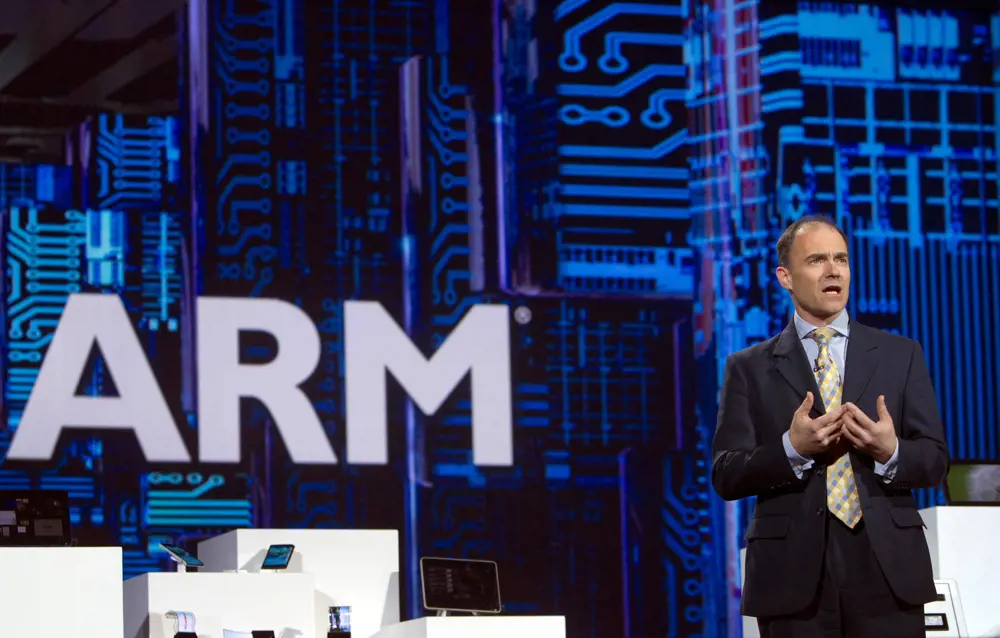
Upon joining ARM, East turned design services into a business. Later, he began focusing on the, then changing, mobile phone market and made changes to the licensing of its chip designs. Business boomed and the company became a stock market favourite © Reuters/Alamy Stock Photo
Extending an arm
Another message was also coming out of TI: the company was closing down its operations in Bedford where East was based. His close encounter with ARM’s technology convinced East that microprocessors were the future, but with TI he would have to move to Nice or Dallas to stay in that sector. Instead, he approached ARM. “I liked microprocessors and I really liked some of the interesting features of the ARM microprocessor.” Clever programming could make its energy efficient microprocessors do fancy digital signal processing.
ARM’s recruitment process proved interesting, East recalls. “I went for a job interview at about 5.00pm in Cambridge.” Around 8.00pm, he got to talk to then CEO, Sir Robin Saxby FREng FRS, one of ARM’s founders. “By about 9.00pm, everyone had gone home. We were wandering around turning lights on and Robin was showing me designs and things. The infectious enthusiasm was there and he did a great selling job. I eventually emerged from ARM at about 10.30pm and phoned my wife saying that I had to go and work for them.”
When East joined ARM in 1994, his licensing expertise kicked in and he set about making serious money from licensees. “If we didn’t monetise it, we would be spending all of our valuable resources designing new ARM processors and helping licensees to design existing ARM processors into applications. They were just treating it as free consultancy.” East moved ARM away from this and turned the free consultancy into a business.
I eventually emerged from ARM at about 10.30pm and phoned my wife saying that I had to go and work for them
ARM’s income comes mostly from a royalty on every chip made. The company had to change its business model to survive; it couldn’t keep on signing up more and more licensees without upsetting existing customers. “With only a small number of licensees and a business model that needed royalties, we needed to encourage people who had bought a licence to use the chip in more designs than the one that they had just bought it for.” At the time, the Apple Newton personal assistant device was one of the few notable products with an ARM chip. “ARM doesn’t make any money until you go into a shop and buy a camera or a phone or a washing machine or whatever.” The answer was to create, and licence, designs that would sell in large quantities. “We had to focus,” says East. “We decided deliberately to focus on mobile phones.”
Some captains of industry might present ARM’s decision as a masterstroke of their own making, but East ascribes the rapid rise, in part at least, to chance. “There is huge luck involved in every successful business,” he says. One piece of luck was changing the focus around the same time as there was a fundamental switch in mobile phone technology moving from analogue to digital signal processing. It also helped greatly that ARM’s energy efficiency microprocessors could squeeze as much running time as possible out of a battery-powered device.
There is huge luck involved in every successful business. One piece of luck was changing the focus around the same time as there was a fundamental switch in mobile phone technology moving from analogue to digital signal processing
ARM was poised to surf a wave that would change the face of electronics. The company had the right engineering at the right time. It grew rapidly and soon reached the stage where it made sense to float the business on the stock exchange. When that happened, the rest of the senior management hit the road and went out talking to investors. “Suddenly, we had to be a public company,” says East “Nobody had heard of ARM; we had to get out and market the company and I was appointed Vice- President of Operations.” Not long after this he became CEO, finally achieving ‘captain of industry’ status.
ARM capitalised on its chip designs; there were so many chips in circulation that it was difficult to find an ‘ARM less’ mobile phone. The business boomed and the company became a stock market favourite. What possessed East to move on at such a high point? “I was having a really good time but I believe that CEOs can stay in a position for too long. The team can get a bit stale around you.” By the time this becomes obvious, things are starting to fall apart and when the CEO finally does depart there is a vacuum of leadership. “I won’t name names,” he adds, “but there are a number of public companies around where arguably the CEOs have stayed for too long. I had a very strong paternal feeling towards ARM by that stage. I could have had a fantastic time there but as I saw it then, I could see another five, six, eight years of having a good time, and then I would be running a serious risk of being labelled the CEO that screwed it all up by staying too long.”
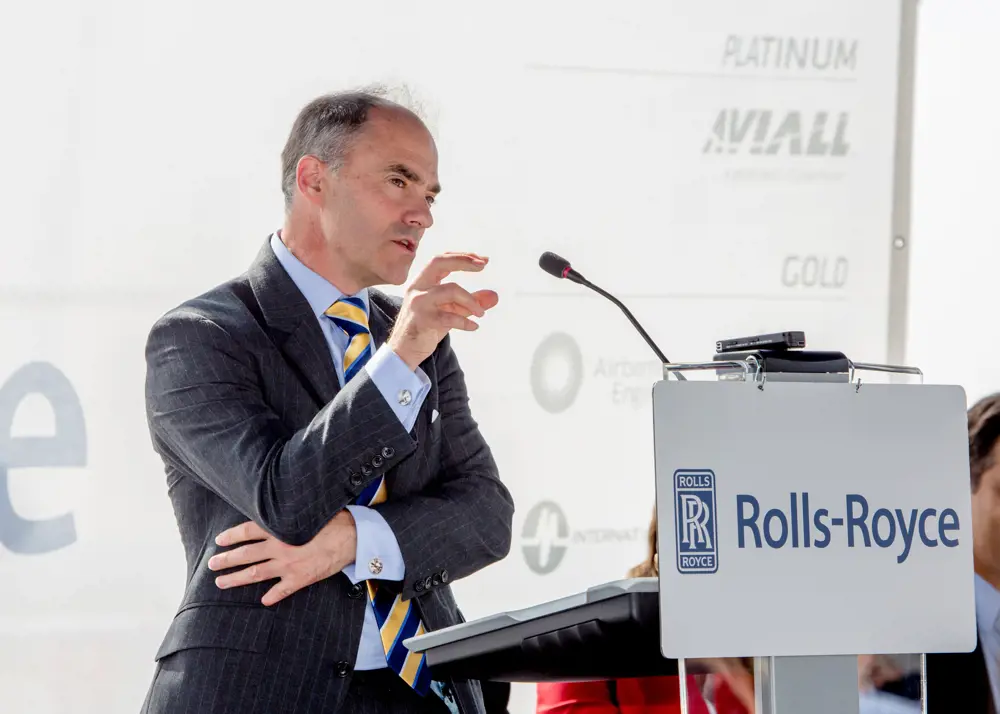
East wants to push Rolls-Royce to be the number one engine maker in civil aerospace and is keen to strengthen the company’s links with universities through its University Technology Centres to encourage more people to get into engineering © Rolls-Royce
Captain of industry
One opportunity that came up after East left ARM was as a non-executive board member of Rolls-Royce, and an invitation to chair the company’s science and technology committee. This fitted in with East’s continuing passion for engineering. “Science and technology are very germane as far as Rolls-Royce is concerned. The science and technology committee allows the board to have some scrutiny of that part of our business.” The fact that Rolls-Royce has a board-level committee thinking about technology, alongside the more traditional audit and other committees, is a rarity even among engineering companies. It underlines the importance of technology to the company, says East.
In the event, East chaired the committee for just a couple of meetings as not long after he joined the board it became clear that the CEO’s job was coming up. “When it became evident that we were going to change the CEO, shortly afterwards I put my hand up and said ‘hang on a minute I can do that’.” Even that short exposure to the company’s operations was a great help when East became CEO. “Most CEOs coming from outside would have a little period of induction and that would be that.” Instead, he could draw on several months’ induction. “After I was appointed, I had another luxury of two months between when we announced it and when I joined.”
Engineering clearly still fascinates East: “I am genuinely interested by some of this stuff.” He admits that it would be all too easy to spend his time on what he calls “industrial tourism”, visiting the company’s many operations. “One day I hope to have a little bit more fun like that, but I am dealing with some very well-publicised commercial issues that we have had, profit warnings and goodness knows what.”
These business issues cannot obscure the fact that Rolls-Royce is an engineering business. “We have a tremendous asset here in our quality of engineering. If I can apply a bit of the philosophy that the engineering is only really good if we can produce things economically as well, then we have an absolute gem. What I’m trying to do now is to apply a bit of engineering context and a bit of business experience that I have gained from ARM and I am putting those together, hopefully for the benefit of Rolls-Royce.”
I would like it to continue to be a British company, but a global company that happens to be headquartered in Britain
Does being an engineer bring a different perspective to those business decisions? “I suppose I am inherently a bit more sympathetic to the engineers,” he explains. “It means that I have a feel for what our products do. I probably have a better feel of quite how difficult it is to make the product do what it is doing. That might make me not so good because I’m not so tough when it comes to deadlines and things.” It also means that East is less likely to come down hard an engineering budgets “because that is our lifeblood and I know what is involved in each turn of the screw”.
East’s ambition is to push Rolls-Royce up the league table of engine makers. “Arguably, it is the number three player in civil aerospace. I would like it to be number one player. I would like it to continue to be a British company, but a global company that happens to be headquartered in Britain.” The signs of upward progress are already there. Rolls-Royce already has a 30% share of all the engines on wide-body airliners. “If you look at orders coming in, then we have about a 50% share today.” It does that despite the fact that, as East puts it, “we spend less money on engineering our engines than our number one competitor, GE Aviation.” GE is much bigger than Rolls-Royce. “It is inconceivable that their R&D budget on engines is not significantly larger than ours, and yet we produce engines where, in a competitive situation, like on the Dreamliner, we are able to win perhaps 60% of the business.”
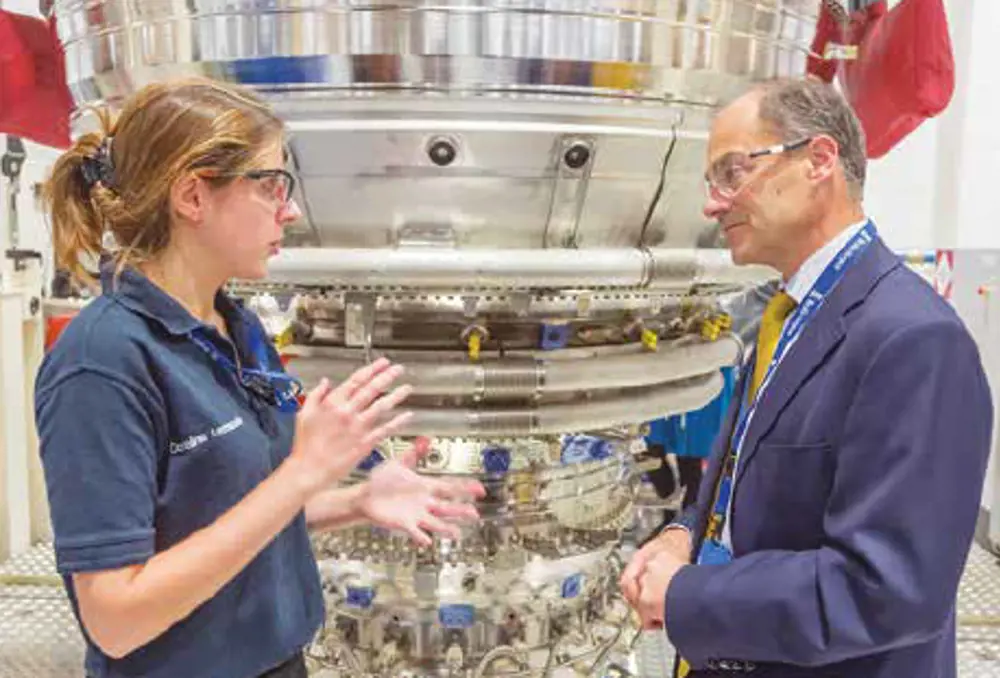
East chats to a worker on the Trent XWB assembly line at Rolls-Royce’s manufacturing plant in Derby.The Trent XWB engine is the world’s most efficient large civil aero engine © Rolls-Royce
Links with academia and industry
Rolls-Royce certainly has interesting ways of making the most of its engineering and R&D. One strong point is in the company’s long-term relationships with the academic world through its series of specialist University Technology Centres (UTCs), role models that other companies have tried to emulate. The company’s UTCs concentrate its academic collaboration into a relatively small number of large centres. “From ARM, I looked on with envy at how successful Rolls- Royce was at working with universities,” says East. The key to this success, he explains, is in taking it seriously. “There is a subtle clarity about what goes on at Rolls-Royce.” The company must put enough people into making the university thing happen. “You put 10 people in and you get 100 people’s worth of activity out. The danger where perhaps people fail is that they think they are going to get a hundred people out for putting two people in.”
With his insights into the engineering at Rolls-Royce and ARM, can East see any parallels? Surely, making massive engines for aircraft is very different from licensing chip designs? “As I look at the whole process of our design and manufacture, it is interesting because I can see things where we are just starting to get to where the semiconductor world was 20 years ago. Although that doesn’t mean to say that we are 20 years behind the semiconductor industry,” he insists. “In the semiconductor industry you don’t build things that operate above the melting points of the materials that you are using for instance.”
Engineering is about taming science for the benefit of society and if it is not economic then is not very beneficial to society
Career timeline and distinctions
Born, 1961. Awarded a bachelor’s degree in engineering science, University of Oxford, 1983. Joined Texas Instruments, 1983. Received an MBA from Cranfield University, 1990. Joined ARM Holdings, 1994. CEO, ARM Holdings, 2001–2013. Fellow of the Institution of Engineering and Technology, 2004. Fellow of the Royal Academy of Engineering, 2007. Named business leader of the year at the National Business Awards, 2007. Distinguished Fellow of the BCS (The Chartered Institute for IT), 2013. Commander of the Order of the British Empire, 2014. Non-executive Director, Dyson, 2013–present. Non-executive Director, Rolls-Royce, 2014–2015. Chief Executive Officer, Rolls-Royce, 2015–present
East has thoughts on how to do better at turning superb engineering into profitable products. “It is all very well to do fantastic designs, but if you can’t make them economically then in my mind that is not very good engineering. Engineering is about taming science for the benefit of society and if it is not economic then is not very beneficial to society. A lot can be done on that,” says East, for example, by “bringing together the designers and the manufacturing engineers sooner rather than later so that the overall answer can be engineered correctly but also manufactured economically.”
***
This article has been adapted from "Taking engineering to industry", which originally appeared in the print edition of Ingenia 69 (December 2016).
Contributors
Michael Kenward OBE
Author
Keep up-to-date with Ingenia for free
SubscribeRelated content
Mechanical
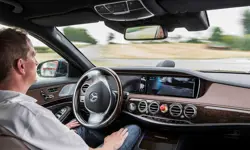
When will cars drive themselves?
There are many claims made about the progress of autonomous vehicles and their imminent arrival on UK roads. What progress has been made and how have measures that have already been implemented increased automation?
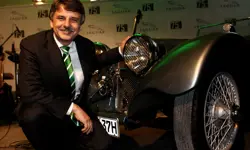
R&D investment makes good business sense
In just five years, Dr Ralf Speth FREng has presided over a revolution in design and manufacturing that has helped create a new family of engines and has overhauled Jaguar Land Rover (JLR) production facilities.

Bikes help improve skills and attitude
The Archway Project is an independently-funded scheme that is expanding its engineering-based programmes by providing BTEC certificates and diplomas. John Milton, the director of the project, explains what the charity does to help reduce anti-social behaviour and improve employment prospects.
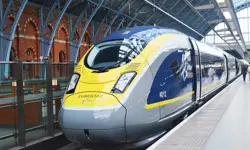
High speed evolution
In December 2010, Eurostar International Ltd awarded a contract for 10 new high speed trains to Siemens. The company has used a system developed over decades to maximise the performance and passenger-carrying ability of its 320km/h trains.
Other content from Ingenia
Quick read

- Environment & sustainability
- Opinion
A young engineer’s perspective on the good, the bad and the ugly of COP27

- Environment & sustainability
- Issue 95
How do we pay for net zero technologies?
Quick read

- Transport
- Mechanical
- How I got here
Electrifying trains and STEMAZING outreach

- Civil & structural
- Environment & sustainability
- Issue 95